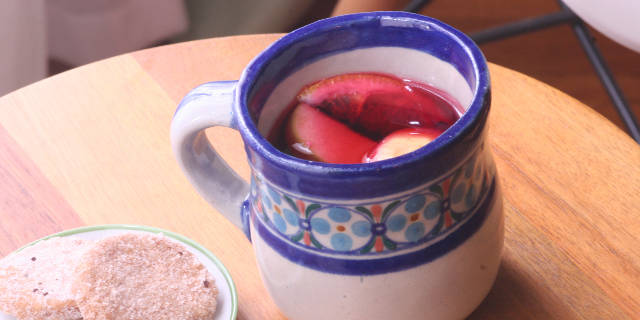An uncle of mine established himself forever as the eggnog king in our family during the holidays. Men rarely ventured into the kitchen in our household, and even as a small child I remember how amused and delighted (and baffled) I was to see him wearing my grandmother’s frilly red apron, madly cranking an old fashioned rotary egg beater, lost in the vision of his magical brew. After making a kid-friendly version, my uncle would unwrap his favorite Irish whiskey and get cooking for the adults. The taste of nutmeg still reminds me of kneeling on the seat of a wooden kitchen chair, elbows on the red checkered tablecloth, my uncle ladling up another serving for my enameled tin cup.
Beverages are the most radiant gemstone in the holidays’ crown of glories. Fond memories can be quietly shared over warm cups of ponche or tiny sips of rompope. Having a drink with friends and family is more central to the holidays than turkey or tamales. Although store bought beer and wine dominate the scene at most gatherings, we are most nostalgic about holiday home brews.
In the Americas, we attribute certain beverages to distinct countries: Coquito to Puerto Rico, Cola de Mono to Chile. But Christmas, Chanukah and the concept of January 1 as the start of the New Year all came with the Spanish from Europe. Prior to the arrival of Columbus, the tribes of the Americas had their own calendars and rituals that were not based on Judeo-Christian beliefs and a majority of holiday traditions in Latin America are derived from what the conquistadores brought from Spain.

Non-cooks might be looking for a reason to avoid the kitchen chaos, and disappearing to create a special beverage for the day is certainly a valid excuse. Thankfully, most beverage recipes are quite easy and can be made in advance. My uncle’s eggnog always trumped whatever was being cooked in the kitchen. We would gather around the cut glass punch bowl, toasting each other before we sat down for the meal. Maybe that was the magic that my uncle was so intent on creating. With this collection of recipes, from coquito to ponche, it’s time to create a bit of your own magic this season. Salud.
And click here for two bonus videos on holiday sides to pair with classic drinks: coconut braised collard greens and Ecuadorian mashed potatoes.



![Making Mealtime Matter with La Familia: Easy Sofrito [Video]](https://thelatinkitchen.com/wp-content/uploads/2015/10/sofrito-shutterstock__0-500x383.jpg)
![Easy Latin Smoothies: Goji Berry Smoothie [Video]](https://thelatinkitchen.com/wp-content/uploads/2015/12/goji_berry-shutterstock_-500x383.jpg)
















![Fun and Fast Recipes: Fiesta Cabbage Salad [Video]](https://thelatinkitchen.com/wp-content/uploads/2015/11/fiesta_cabbage_slaw-shutterstock_-500x383.jpg)









